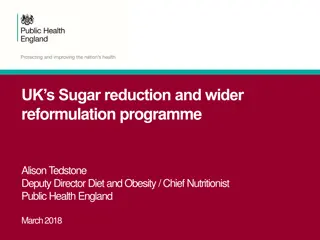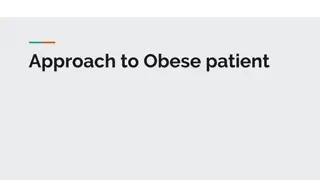Understanding Childhood Obesity and Environmental Influences
Research examines the relationship between childhood obesity and food/physical activity environments, highlighting disparities in access to healthy options and presenting inconsistent findings regarding the impact of food access and physical activity opportunities on obesity. Various factors contribute to conflicting results, including different age groups studied, variations in geographic characteristics, and types of measurements used.
Download Presentation

Please find below an Image/Link to download the presentation.
The content on the website is provided AS IS for your information and personal use only. It may not be sold, licensed, or shared on other websites without obtaining consent from the author. Download presentation by click this link. If you encounter any issues during the download, it is possible that the publisher has removed the file from their server.
E N D
Presentation Transcript
Examining the Relationship Between Childhood Obesity and the Food and Physical Activity Environments Punam Ohri-Vachaspati, PhD, RD Arizona State University Collaborators: Kristen Lloyd, MPH; Derek DeLia, PhD; David Tulloch, PhD; Michael Yedidia, PhD
Presenter Disclosures Punam Ohri-Vachaspati No relationships to disclose
Outline o Disparities in access to food and PA opportunities o Food and PA environments and children s weight outcomes o Current study Objectives Design Analysis Results Conclusions
Disparities in Access to Healthy Food and PA Opportunities Lower Income & Communities of Color Higher Income & Less Diverse Communities Preponderance of unhealthy options Easier access to supermarkets Limited PA opportunities Better access to PA opportunities Zenk et al, 2006; Morland & Filomena, 2007; Kipke et al. 2007; Sturm, 2008, Larson et al. 2009
Inconsistent Findings of Relationship Between Food Access and Childhood Obesity Positive Associations Availability of supermarkets associated with lower BMI (Powell et al, 2007) Proximity to LSR associated with higher BMI (Davis and Carpenter, 2009; Mellor et al, 2011) Proximity to convenience store associated with higher BMI (Galvez, 2008; Laska et al. 2010; Leung et.al. 2011) Lack of Association Any type of food environment (An and Sturm, 2012; Lee 2012) Specific types of food environments (Laska et al. 2010; Leung et.al. 2011; Howard et al. 2011)
Inconsistent Findings of Relationship Between PA Opportunities and Childhood Obesity o Positive Associations PA facilities and parks associated with reduced risk of overweight or obesity (Gordon-Larsen, 2006; Wolch et al. 2011) o Lack of Associations No association between proximity to parks and PA facilities (Burdette and Whitaker, 2004; Kligerman et al 2007)
Potential Reasons for Conflicting Results o Different age groups investigated o Study of either food OR PA environment o Variations in the geographic characteristics of the environment studied o Variation in types of measurements used
Objectives Using data from four urban, low-income, racially diverse cities in NJ this study investigates the role of food and PA environments by considering a variety of potentially important measures of proximity and assesses the association between weight status of children in a broad spectrum of age groups.
Study Design Data Sources Household survey (2009-2010) of 1408 households in 4 NJ cities (Camden, Newark, New Brunswick, Trenton) Households with children ages 3-18 yrs Demographic characteristics of household and neighborhood Geo-coded location of residence Respondent measured weights and heights GIS data on food and PA outlets food outlets classified using a standardized methodology (Ohri-Vachaspati, 2010)
Study Design - Measures o Outcome: Dichotomized indicator of child weight status o Exposure: proximity to food and PA outlets to each child s residence Presence in varying radii ( mile, mile, 1 mile) Roadway network distance to the nearest outlet Counts of food and PA outlets in varying radii ( mile, mile, 1 mile) o Control variables: Demographics, parent BMI, neighborhood SES
Analysis o Bivariate associations between exposure and outcome o Multivariate logistic regression to assess the association controlling for demographic variables and parent BMI o Data weighted to be representative of 3-18 year olds in the four study cities o Analysis adjusted for complex survey design
Results Demographic and Neighborhood Characteristics of Children and Associations with Weight Status (unweighted n =702) Characteristic Child: Overweight or obese ( 85th percentile) % or Mean (SE)b 38.1 (2.5) Child Age** 2-5 yrs 6-11 yrs 12-19 yrs 15.7 (1.8) 40.6 (2.2) 43.7 (2.5) Child: Female 48.8 (2.4) Child Race/Ethnicity** Non-Hispanic white Non-Hispanic black Hispanic Other race 7.1 (1.8) 47.8 (3.2) 40.1 (3.1) 5.0 (1.5) bSample weighted and SE adjusted for complex survey design *p<0.10 in bivariate logit model with child s weight status **p<0.05 in bivariate logit model with child s weight status
Results Demographic and Neighborhood Characteristics of Children and Associations with Weight Status (unweighted n =702) Characteristic Parent: Foreign-born** % or Mean (SE)b 31.4 (3.0) Household: Non-English* 27.0 (2.7) 80.5 (2.2) Household: 200% of poverty line Mother s education* High school or less Some college College graduate or higher Parental BMI ** 58.7 (3.2) 26.2 (2.8) 15.1 (2.4) 30.0 (0.5) Median Income in Block Group** $35,746 ($925) Race/Ethnicity: Percentage in Block Group Non-Hispanic black Hispanic Other race bSample weighted and SE adjusted for complex survey design *p<0.10 in bivariate logit model with child s weight status **p<0.05 in bivariate logit model with child s weight status 49.5 (2.1) 35.4 (1.6) 3.8 (0.3)
Results Distributions of Objective Measures of Neighborhood Food and Physical Activity Environment FOOD ENVIRONMENT GEOSPATIAL VARIABLES % or Mean (SE)b PA ENVIRONMENT GEOSPATIAL VARIABLES % or Mean (SE)b Miles to nearest Supermarket Small Grocery store Convenience store Fast-food restaurant Presence in mile radiusd Supermarket 0.72 (0.02) 0.48 (0.02) 0.18 (0.01) 0.21 (0.01) Miles to nearest Park (1 acre or more) 0.28 (0.01) 11.5 (2.4) PA facility Presence in mile radiusd Park ( 1 acre) 0.71 (0.03) Small Grocery store Convenience store Fast-food restaurant 26.1 (3.0) 88.8 (2.4) 82.9 (2.2) PA facility 37.2 (3.0) 68.5 (2.9) b Sample weighted and SE adjusted for complex survey design d Radius measurement based on road distances
Results Distributions of Objective Measures of Neighborhood Food and Physical Activity Environment some have no variability PA ENVIRONMENT GEOSPATIAL VARIABLES % (SE)b % (SE)b FOOD ENVIRONMENT GEOSPATIAL VARIABLES Presence in 1 mile radiusd Park ( 1 acre) PA facility Presence in 1 mile radiusd 100.0 (--) Supermarket 80.1 (1.8) 78.4 (2.8) Small Grocery store Convenience store Fast-food restaurant 90.9 (1.6) 98.9 (0.5) 99.8 (0.1) b Sample weighted and SE adjusted for complex survey design d Radius measurement based on road distances
Results Unadjusted OR of Being OW/OB (95% CI)b Geospatial variable Bivariate Association Between Objective Measures of Neighborhood Food and Physical Activity Environment and Child s Weight Status (Unweighted sample size = 702) Miles to nearest Supermarket Small Grocery store Convenience store Fast-food restaurant Presence in mile radiusd Supermarket Small Grocery store Convenience store Fast-food restaurant Presence in mile radiusd Supermarket Small Grocery store Convenience store Fast-food restaurant Number of outlets in mile radiuse Supermarket Small Grocery store Convenience store Fast-food restaurant 1.12 (0.76, 1.66) 0.70 (0.41, 1.18) 0.18 (0.05, 0.63)** 0.47 (0.13, 1.69) 0.82 (0.52, 1.29) 1.08 (0.70, 1.67) 3.54 (1.14, 10.98)** 2.46 (0.99, 6.16)* 0.55 (0.26, 1.17) 0.96 (0.59, 1.56) 1.99 (1.15, 3.45)** 0.83 (0.52, 1.30) 0.61 (0.33, 1.10) 1.03 (0.83, 1.27) 1.09 (1.00, 1.20)* 1.01 (0.95, 1.08) b Sample weighted and SE adjusted for complex survey design d Radius measurement based on road distances e Radius measurement based on shortest distance between two points *p<0.10 in bivariate logit model with child s weight status **p<0.05 in bivariate logit model with child s weight status Presence in mile radiusd Park (1 acre or more) PA facility 0.36 (0.18, 0.75)** 0.85 (0.55, 1.31)
Results Multivariate logistic regression analysis of the association of proximity to elements of the food and physical activity environment with child s weight status Key Geospatial Predictor(s)a Distance to nearest (miles) Convenience store Presence in mile radius Convenience Store Fast-Food Restaurant Park (1 acre or more) Presence in mile radius Convenience store Number in mile radius Convenience store Adjusted OR of Being OW/OB (95% CI)b 0.33 (0.08-1.36) 1.41 (0.34-5.72) 1.42 (0.48-4.24) 0.45 (0.24-0.86)** 1.82 (1.01-3.28)** 1.11(1.00-1.22)** aMultivariate regressions were run for geospatial variables having a significant (p<0.1) bivariate association with child s weight status b Sample weighted and SE adjusted for complex survey design; Each model controlled for child s age, race/ethnicity, parental nativity, mother s education level, household language status, parental BMI, and median income in the block group of child s residence. **p<0.05
Summary o Children living within a mile of a convenience stores have almost twice the odds of being overweight of obese o Children living within a mile of a park have less than half the odds of being overweight of obese
Implications for Methodology o Are the measures of proximity meaningful for the locales under study? o Do the areas under study have similar geospatial landscape? o Does the ubiquity of outlets make it difficult to observe associations?
Conclusion o Living in close proximity to convenience stores and parks may influence weight outcomes in children 3-18 years old o It is important to select measures of proximity that are suited to the geospatial landscape of community under study
Supported by a grant from The Robert Wood Johnson Foundation
Thank You! Contact information: Punam.Ohri-Vachaspati@asu.edu























